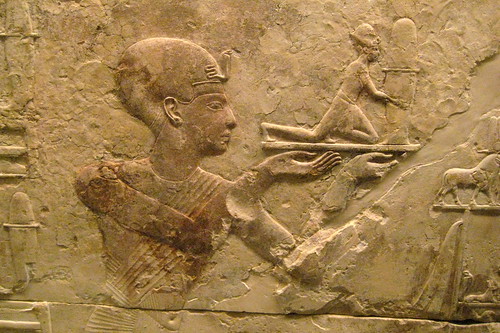NYC – Metropolitan Museum of Art – Chapel for Ramesses I at Abydos – West Wall

Image by wallyg
Chapel for Ramesses I at Abydos – West Wall
Dynasty 19, reign of Sety I
(ca. 1291-1279 B.C.)
Limestone
The site of Abydos lies on the west bank of the Nile in Upper Egypt, some 275 miles south of modern Cairo and 60 miles northwest of Luxor (ancient Thebes). Throughout ancient history, Abydos was sacred to Siris, the god of resurrection, who was also called Onnophris (from the Egyptian wnn-nfr, "continually rejuvenated"). In Egyptian belief, Osiris was the force that brought life out of apparent death, manifest in such natural phenomena as the daily sunset and sunrise and the yearly growth cycleof plants. He was also the god who ruled the netherwold, while his son, Horus, governed the living on earth. During his reign, each pharaoh was identified with Horus and after death, was thought to become Osiris.
From the beginning of dynastic history, Egypt’s rulers sought to erect memorial buildings and temples for themselves in the "Sacred Land" of Abydos, where they might be remembered in their union with Osiris and participate in the annual reenactment of the god’s death and resurrection. Although the earliest of these memorials dates to the time of Egypt’s unification (ca. 3200 B.C.), the largest is that of Sety I (Dynasty 19, ca. 1291-1279 B.C.). Sety’s temple contains chapels for the worship of the Abydene triad–Osiris; his wife, Isis; and their son, Horus–as well as one for Sety’s own posthumous veneration as Osiris. The relief in Sety’s temple is generally considered the finest of the Ramesside period and among the best ever produced by ancient Egyptian artists.
Some fifty feet north of his temple enclosure, Sety built a much smaller but equally well decorated memorial chapel for his father Ramesses I (Dynasty 19, ca. 1293-1291 B.C.). Ramesses was probably general, and later viziet under Horemhab (last king of Dynasty 18, ca. 1321-129 B.C.) and came to the throne after Horemhab died childless. Apparently well advanced in years, Ramesses ruled for little more than two years himself. The task of building his memorial therefore became the pious duty of his son and successor, Sety.
The chapel was discovered in 1910, during construction work northeast of Sety’s own memorial. Because it was on private land, Egyptian law at the time recognized the discovery as private property and the finders were allowed to sell the reliefs. Most of them were acquired by J. Pierpont Morgan in 1911 and presented to the M useum of Metropolitan of Art. Three additional blocks were given to the Museum in 1912 by Dikran Kelekian, and another three blocks recorded in 1910 are now lost.
The Egyptian Antiquities Service acquired the site of the chapel itself during the World War I. Because most of the reliefs had by that time come to the Metropolitan, the Museum was aked to conduct formal excavations. In 1927, these revealed the plan of the chapel and a number of additional inscribed blocks, most in very poor conditio which were restored and left in situ.
The west wall is the focal point of the chapel. It is divided centrally, with scenes of Ramesses I on the right and those of his son Sety I on the left. In the two scenes from the bottom register that are preserved here, Osiris’s image is replaced by the god’s Abydene cult symbol.
On the right, Ramesses, described as "maker of monuments in the Abydene, nome for the lord of continuity, who satisfies the heart of Onnophris with what he has desired", presents offerings to the symbol accompanied by Isis. On the left, Sety, described as "doet of effective things for Onnophris, caretaker of the Ennead of the Sacred Land," presents a statue of himself offering a jar of myrrh to the symbol accompanied by Horus. In return for the offering, Osiris says to Sety: "My chosen son of my body, lord of Two Lands, Menmaatre, my heart is happy and content because you have acted. You are my son and protector. As long as the sky exists, your deeds will exist."
The upper register (now lost) centered on the djed pillar, symbol of Osiris. To the right, Ramesses was shown offering a bouquet to the statue of Osiris accompanied by Isis. To the left, Sety presented offerings to the statue of Osiris accompanied by "Horus, son of Osiris."
Gift of J. Pierpont Morgan, 1911 (11.155.3b)
**
The Metropolitan Museum of Art‘s permanent collection contains more than two million works of art from around the world. It opened its doors on February 20, 1872, housed in a building located at 681 Fifth Avenue in New York City. Under their guidance of John Taylor Johnston and George Palmer Putnam, the Met’s holdings, initially consisting of a Roman stone sarcophagus and 174 mostly European paintings, quickly outgrew the available space. In 1873, occasioned by the Met’s purchase of the Cesnola Collection of Cypriot antiquities, the museum decamped from Fifth Avenue and took up residence at the Douglas Mansion on West 14th Street. However, these new accommodations were temporary; after negotiations with the city of New York, the Met acquired land on the east side of Central Park, where it built its permanent home, a red-brick Gothic Revival stone "mausoleum" designed by American architects Calvert Vaux and Jacob Wrey Mold. As of 2006, the Met measures almost a quarter mile long and occupies more than two million square feet, more than 20 times the size of the original 1880 building.
In 2007, the Metropolitan Museum of Art was ranked #17 on the AIA 150 America’s Favorite Architecture list.
The Metropolitan Museum of Art was designated a landmark by the New York City Landmarks Preservation Commission in 1967. The interior was designated in 1977.
National Historic Register #86003556
Tags:Abydos, Chapel, Metropolitan, Museum, Ramesses, wall, west


0 comments:
Post a Comment